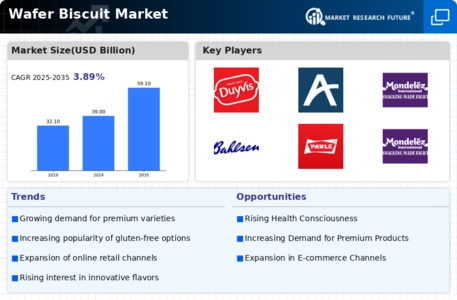Market Growth Projections
The Global Wafer Biscuit Market Industry is poised for substantial growth, with projections indicating a market value of 39.0 USD Billion in 2024 and an anticipated increase to 59.1 USD Billion by 2035. This growth trajectory suggests a compound annual growth rate (CAGR) of 3.86% from 2025 to 2035. Such projections underscore the increasing popularity of wafer biscuits as a snack option across various demographics. Factors contributing to this growth include rising disposable incomes, changing consumer preferences, and the ongoing innovation in product offerings. The market's expansion reflects broader trends in the snack food sector, indicating a promising future.
Innovative Flavor Profiles
Innovation in flavor offerings plays a crucial role in driving the Global Wafer Biscuit Market Industry. Manufacturers are increasingly experimenting with unique and diverse flavors to cater to evolving consumer preferences. This trend not only attracts new customers but also encourages repeat purchases among existing consumers. For instance, the introduction of exotic flavors such as matcha, salted caramel, and spicy variants has gained traction in various markets. Such innovations are likely to enhance brand loyalty and expand market share, contributing to an anticipated CAGR of 3.86% from 2025 to 2035, as companies strive to differentiate their products in a competitive landscape.
Rising Demand for Snack Foods
The increasing consumer inclination towards convenient snack options is a pivotal driver for the Global Wafer Biscuit Market Industry. As lifestyles become busier, individuals seek quick and portable snacks that can be consumed on the go. This trend is particularly evident in urban areas where time constraints are prevalent. In 2024, the market is projected to reach 39.0 USD Billion, reflecting the growing appetite for wafer biscuits as a preferred snack choice. The demand is expected to continue its upward trajectory, potentially leading to a market valuation of 59.1 USD Billion by 2035, indicating a robust growth potential.
Health-Conscious Consumer Trends
The shift towards healthier snacking options is significantly influencing the Global Wafer Biscuit Market Industry. Consumers are increasingly seeking products that align with their health and wellness goals, prompting manufacturers to develop biscuits with reduced sugar, whole grains, and added nutritional benefits. This trend is particularly pronounced among younger demographics who prioritize health-conscious choices. As a result, brands that successfully market their products as healthier alternatives are likely to capture a larger share of the market. This focus on health is expected to sustain growth, with the market projected to reach 59.1 USD Billion by 2035, reflecting the changing consumer landscape.
Sustainable Packaging Initiatives
The increasing emphasis on sustainability is shaping the Global Wafer Biscuit Market Industry, particularly in terms of packaging. Consumers are becoming more environmentally conscious, prompting brands to adopt sustainable packaging solutions. This shift not only aligns with consumer values but also enhances brand reputation and loyalty. Companies that invest in eco-friendly packaging materials and practices may gain a competitive edge in the market. As sustainability becomes a key consideration for consumers, the demand for wafer biscuits packaged in environmentally friendly materials is likely to rise, further driving market growth.
E-commerce Growth and Accessibility
The expansion of e-commerce platforms is transforming the Global Wafer Biscuit Market Industry by enhancing product accessibility. Online shopping provides consumers with the convenience of purchasing their favorite wafer biscuits from the comfort of their homes. This trend has been accelerated by the proliferation of mobile devices and internet connectivity, allowing consumers to explore a wide range of products and brands. E-commerce not only facilitates easy access but also enables brands to reach a global audience, thereby driving sales. As the market continues to evolve, the integration of e-commerce strategies is likely to play a pivotal role in achieving sustained growth.























